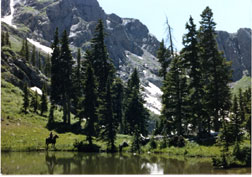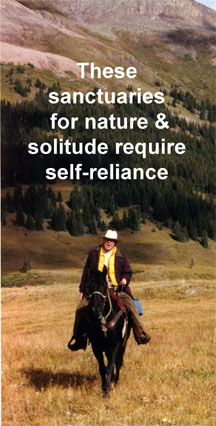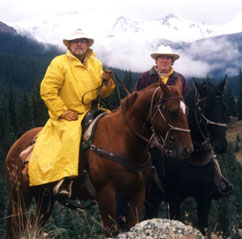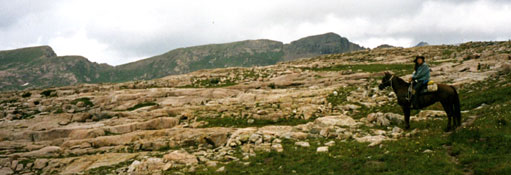 |
|||
Writing |
|||
Anyone can set their mind to be a writer. Routinely Larry and I find ourselves on a long day ride on our good horses in the back country pushing through brush with a pack horse in tow. Our bodies become overly exercised at trails-end but there is little ache. Fatigue is eclipsed by being in one with ourselves, each other, nature and beast. Our minds do not wonder, only to be here now. If you are not living for the moment, then you’re missing the lessons, unable to observe and take notes. Good writers take good notes. A writer reads the work of others. Writing is an act of passion for sharing knowledge and experiences that serve to inspire others. A big heart insures good intent. |
 |
||
How does a writing life evolve? For me, childhood preparation of class essays and term papers were easy to complete. A strict English teacher was helpful. Preparing debate team and speech notes were enjoyable. Editing a college newspaper gave a sense of accomplishment. Writing letters to friends and family are treasured pieces. Reading the editorials of others and responding in kind leads to good debate. Researching technical writing is an investigative journey. Marketing the Seventy Seven Outfit is reaching for success. Please contact us if we can be of service to you for editing, proofreading, technical writing, grants, investigative reporting, brochures, personal resumes, HACCP plans and short stories. |
|||
Happy TrailsIn the backcountry, you're better off on four feet than two By Sandy Young |
|||
 |
There are a lot of good horses kept here in our community that work in the backcountry. They are the packhorses, the cowboy’s ride, an outfitter’s bell mare, a cattlemen’s handy cutter, a dude’s steady steed or a recreational horsemen’s trusted friend. These well-respected animals need open space and an agricultural base to keep them in feed. Long live the presence of agriculture, horses and all livestock in our community! The San Juan National Forest and other public lands that surround Durango are certainly treasures to behold. For many of us, having access to this open space is why we live here and work for lower wages. These sanctuaries for nature and solitude require self-reliance from all those who visit. A prepared and confident horseman who knows and trusts his good horse will most often enjoy safe passage. You’re better off on four feet than two.How do you gain the experience and confidence for riding horses in the backcountry? You may be lucky enough to be born into a rancher or outfitter family in which horseback riding and working in the mountains becomes second nature. There are plenty of us who have ridden horses all our lives and only lack the experience of riding in the backcountry. Sign on as a greenhorn for a dude or cow outfit and you can quickly change that. Buy in on a pack trip and learn from a guide and outfitter. You may be fortunate to have friends with horses. Sit around a horseman’s campfire and take in the tall tales. |
||
Being active in horsemen’s groups like the Four Corners Back Country Horsemen can help you attain knowledge and experience. A main purpose of this group is to educate people about horses and the backcountry. Some members perform volunteer trail work with their horses, a rewarding experience indeed. What is there to learn? A short list includes the horses, their behavior, their physical condition, care and equipment. Include the skills for survival and safety in the backcountry: setting camp, performing first aid and rescue, map reading, using GPS, knot tying and weather observing. Don’t forget trail etiquette. Can you drive a truck and trailer? Know your limitations. All users of public lands need to have a consciousness for low-impact use so these backcountry resources remain renewable and available for future generations. |
 |
||
The day you think you know everything there is to know about yourself, your horse or the backcountry; than that is the first day your chances to get in trouble increase. Like many things that get better with age, so do the abilities of backcountry horsemen who keep an open heart and mind. |
|||
 |
|||
There are programs that support well-trained search and rescue teams in our community. Purchasing a Colorado Outdoor Search & Rescue Card does just that. For $3 annually, the card helps insure that there are people in place to perform backcountry rescue missions. You’ll be glad to have this card in your pocket if you should ever need to be rescued from an unfortunate situation in Colorado ’s backcountry. Happy trails! |
|||
Mad cow threat opens the door to grass-fed beefMark Dowie, Writers on the Range |
|||
The predictable re-emergence of mad cow disease on American shores brings to mind the Mandarin Chinese word for crisis -a combination of the ideograms for danger as well as opportunity. The danger is obvious and growing, as mathematical probability tells us there must be more than two mad cows among the 112 million or so in our national herd. More will be found, and the crisis will grow. And so will the opportunity for anyone producing and marketing healthy beef. Natural, organic and grass-fed meat are all sure to attract the attention of careful meat-eaters. Because of all the better beef technologies, grass-fed is the safest from Bovine Spongiform Encephalopathy. In fact, it would be virtually impossible for a calf born on a grass-only ranch or farm, fed only on its mother's milk, weaned and raised on local grass or hay, to contract BSE. Grass-feeding offers beef eaters the Only 100 percent guaranteed source of prion-free meat. |
|
||
But how do we find it? The main problem, for grass-fed producers and consumers alike, has been market infrastructure. It just isn't there. The combination of low volume, high capital requirements, overcautious investors and a complete lack of interest on the part of mainstream packers has forced grass-only ranchers to become their own marketers, either directly from the farm, through small local brokers or through one of the small grass-fed cooperatives that have sprung up around the country. What appears to be working for some ranchers is to simply set aside a few steers every year, raise them on grass, and sell directly to restaurants and local buyers willing to buy a quarter of butchered meat. Mark Harris, whose ranch in central Montana runs about 1,000 cows, set aside 45 steers last year for the grass-fed market, up from 15 the year before. He's expecting demand from the nearby communities of Billings , Livingston and Bozeman to grow as consumers become more aware of the health advantages of grass-fed meat. But for larger, all-grass operations, the problem remains demand. It still isn't there. So Harris would be taking an unacceptable risk converting his whole ranch. The grass-fed message, which has sounded more like sentimental pure-food evangelism than traditional meat marketing, has not persuaded enough consumers that me product is safer and thus worth the extra cost or effort. That will surely change as the horrors of new variant Creutzfeldt-Jacob Disease become better known and more mad cows appear from crowded feedlots, finished on things they were never supposed to eat. An opportunity is opening for an enterprising packer to make the switch from feedlot-fed to grass-fed beef. It wouldn't have to be one of the gigantic four which dominate conventional meat production. But whoever makes the move should be national in scope, well-capitalized, and experienced at selling and delivering fresh meat to a fast-growing market. This would be good news for the Tallgrass Prairie Producers Cooperative, composed of 10 ranches and an office in central Kansas . It went out of business in 2000 after five tough years of learning painful lessons about self-marketing beef. Now, they're thinking of kick-starting the venture back into play. But as Annie Wilson, a member of the co-op, says, "A successful business needs access to volume markets to reach breakeven." That's something an isolated rural cooperative can rarely find, and it's also missing in the West's urban settings. Grass-fed ranchers Mike and Sally Gale in Chileno Valley , Calif. , say their phone has been ringing off the hook since the first mad cow story broke. "We've had over 50 new customers, including restaurants and food retailers, call during the first month after the story broke, some from out of state. If there was a packer-distributor who knew how to slaughter and process grass-fed beef and distribute it nationwide, there would be thousands of new outlets, retail and wholesale," says Mike Gale. "I could refer customers directly to them. And if there was special stockyard sales of grass-fed animals, and ranchers didn't have to rely on local cattle brokers, they'd go grass-fed in a heartbeat. With the constant threat of BSE in the food chain, it would seem like a great way to go." The Gales and hundreds of other small ranchers committed to raising healthy beef on grass are hoping that just one national packer will make the switch. It would be a tipping point for their product. "And one day," says Mike Gale with a grin, "we might even seem normal." |
|||
| Mark Dowie is a contributor to Writers on the Range, a service of High Country News (hcn.org). He lives in cattle country about 50 miles north of San Francisco and teaches at the University of California Graduate School of Journalism in Berkeley . This article was published in the Durango Herald on Sunday, August 28, 2005. | |||